Power plants of the world
29 April 2021
(Editor’s note: This story first appeared in the Spring issue of Diesel & Gas Turbine Worldwide magazine) Each year, Diesel & Gas Turbine Worldwide asks prime-mover original equipment manufacturers to submit one specific power generation project they feel merits special attention because of advances in one or more of the following areas: efficiency increase, environmental aesthetics, operation characteristics, emissions improvements or construction principles. Here are some of the most innovative power generation installations around the globe.
A first for GE
Southern Power Generation’s 1440 MW Combined Cycle track 4A power project
Malaysia is targeting a 45% reduction in CO2 emissions by 2030. The country of 33 million consists of several large, hilly islands and a peninsula where open land suitable for building large wind or solar farms are scarce. The country’s recent economic growth has driven a steady increase in power capacity, answering the increasing need for more electricity, however, there is a need to achieve the right balance between cost and environmental impact.
Most of the electricity generated in Peninsular Malaysia is based on coal plants as this is the cheapest solution for $/kWh. Today, coal plant contributes to about 65% of electricity generated in Peninsular Malaysia. However, in line with government aspirations, there is a strong commitment from industry players for reduced/ near zero carbon emissions for their operations.
With the country’s latest development plan to add more renewable power while reducing dependence on coal, gas power remains critical for the country’s prosperity.
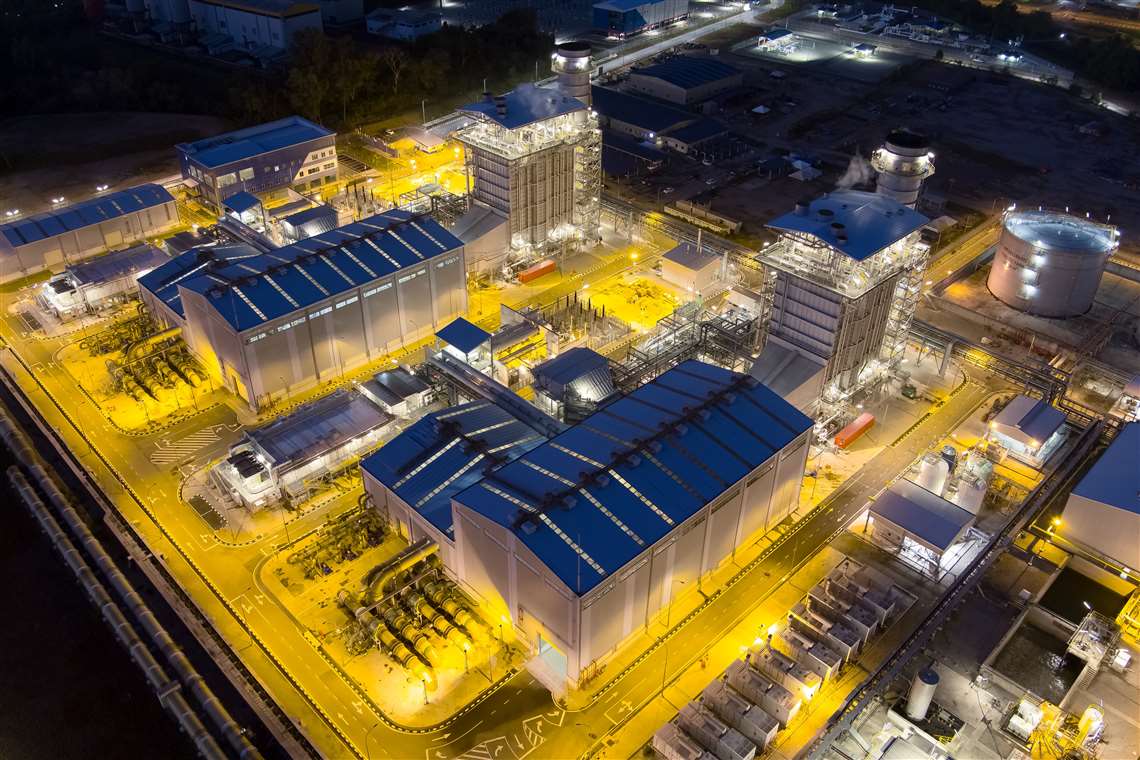 On February 2021, Southern Power Generation’s gas-fired Track 4A Power Plant went online with 1440 MW.
On February 2021, Southern Power Generation’s gas-fired Track 4A Power Plant went online with 1440 MW.
GE’s giant 9HA.02 gas turbine debuts
On February 2021, Southern Power Generation’s gas fired Track 4A Power Plant went online with 1440 MW. The plant is located in Pasir Gudang, an industrial city at the southern tip of Malaysia’s peninsula, just a few miles from Singapore. It will power approximately 3 million homes.
The plant consists of two generating blocks, each equipped with a 9HA.02 gas turbine and a STF-D650 steam turbine, driving a W88 generator, and, for the first time installed in an H-Class Plant, a GE Once Through (OT) Heat Recovery Steam Generator (HRSG). GE’s OT HRSG technology is a key enabler in advanced water-steam cycles delivering higher combined cycle efficiency.
Track 4A power plant is powered by GE’s first 9HA.02 gas turbines in commercial operation globally. The turbines come from a new generation of GE machines that had already set a world power plant efficiency record. The 9HA.02 integrates advances in additive manufacturing and combustion breakthroughs present also in the 7HA.01 and 7HA.02 models. The 9HA.02 features a DLN 2.6e combustor with axial fuel staging (AFS) which enables lower nitrogen oxide (NOx) emissions with improved turndown. In addition it embeds an evolutionary improvement to the premixing fuel nozzles, a technology GE developed in collaboration with the U.S. Department of Energy to deliver improvements in terms of performance, emissions, and fuel flexibility.
The combustion system DLN 2.6e allows the turbine to burn up to 50% by volume of hydrogen when blended with natural gas. In the future, the system could be adjusted to run on 100% H2. This capability is enabled by the DLN2.6e combustion system that is standard on current HA gas turbines offerings. Hydrogen is not the only path for decarbonizing gas turbines. GE’s H-class Combined Cycle Plants can also be configured with a post-combustion capture system to reduce CO2 emissions by up to 95%.
Advanced analytics across the plant
The plant is controlled by GE’s Mark VIe integrated Plant Control System. Equipped with a single Operator Interface and common troubleshooting tools, plant personnel can operate the plant more efficiently and, when issues do arise, rapidly recover to improve overall plant availability. Featuring superior responsiveness and flexibility, it enables plant operators to dispatch power to the grid quickly.
For 21 years, overall plant performance will be monitored and enhanced with GE Digital’s Predix Asset Performance Management software to help improve asset visibility, reliability, and availability while reducing operating and maintenance costs. In addition, data collected from sensors throughout the facility will be monitored and analyzed 24/7 at GE’s Monitoring & Diagnostics (M&D) Center in Kuala Lumpur.
Safety during a pandemic
This plant was safely constructed with the Taiwanese EPC partner, CTCI. Despite the COVID-19 pandemic, CTCI and GE have collaborated together without compromising on health and safety.
The turbines arrived in modular containers that enabled engineers to install them relatively quickly. GE’s H-class machines are engineered with more modular architecture that allows for quicker inspection and maintenance activities, resulting in better reliability. In addition, GE engineers and manufactures all major combined cycle equipment in-house for a full-system approach. GE’s full system approach enables high power output and efficiency as well as improved plant operability.
CTCI and GE have achieved more than 10 million safe man-hours on this project, a testament to the team’s reliability. The two companies’ joint success also paved way to another recent partnership in late 2020, helping GE win a multi-billion dollar EPC contract for five combined cycle gas power units in Taiwan. Together with GE’s expertise and support on site, this will ensure the long-term operations and sustained power dispatch to the grid.
“The world’s first commercial operation of our flagship turbine marks a tremendous milestone for our HA fleet,” said Ramesh Singaram, president and CEO of GE Gas Power in Asia “We look forward to helping Southern Power Generation reap the benefits of our latest technology as well as combined services and digital solutions, helping to deliver more reliable and flexible power generation for the country.”
Power in a time of crisis
MWM power plant keeps ventilator maker running smoothly
Dräger is a leading international maker of medical and safety technology products, including ventilators. In the current pandemic, it’s no surprise that the Lübeck, Germany-based company has great demand for its products, especially for the ventilators it produces. The company’s headquarters on Moislinger Allee in the Hanseatic city of Lübeck manage the production facilities and sales companies around the globe. To make sure that everything works smoothly at all times—not only in times of crisis—a dedicated MWM cogeneration power plant supplies about 30% of the heat and power. A substantial amount of energy is needed for the workforce of 3000 at the Moislinger Allee site.
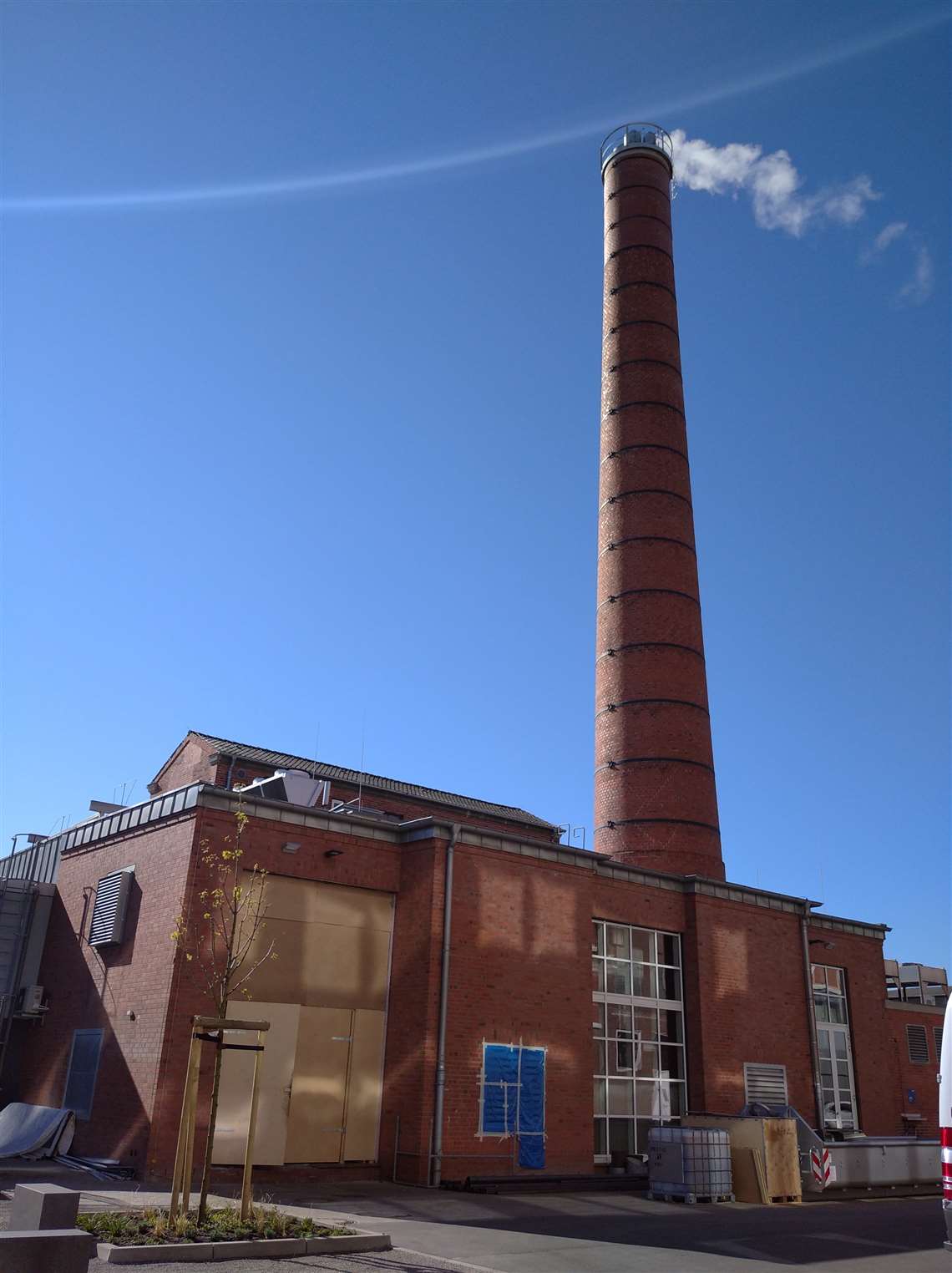 Dräger, a leading international maker of medical and safety technology products, opted to update the core of its cogeneration power plant in 2020 with an MWM TCG 2020 V12 gas genset with improved efficiency.
Dräger, a leading international maker of medical and safety technology products, opted to update the core of its cogeneration power plant in 2020 with an MWM TCG 2020 V12 gas genset with improved efficiency.
Reliable supply
When the cogeneration power plant was first set up in 2007, Dräger opted for reliable, efficient MWM engine technology in the form of a TCG 2020 V12. After 13 years of smooth operation, the core of the cogeneration power plant was replaced in 2020 with an MWM TCG 2020 V12 gas genset with improved efficiency.
“By replacing the engine of the Dräger cogeneration power plant, we want to achieve even more carbon savings and improve the profitability”, said Sören Sievertsen, project manager at Stadtwerke Lübeck. In the past, the cogeneration power plant was operated directly by Dräger; now, this will be handled by Stadtwerke Lübeck under a contracting arrangement.
The heat-controlled cogeneration power plant supplies heat energy and power for Dräger and heat energy for various service providers on the premises. All of the generated heat is used for heating the workplaces in the factory halls and offices, and almost all of the 1 MW of power that will henceforth be produced will be used locally and will not be fed into the local power grid. “In this way, we are able to cut Dräger’s power costs, as self-generated power is not subject to additional levies”, explains Björn Verwold, account manager at Stadtwerke Lübeck. Thermal output is 1272 kW, thermal efficiency is 53%, electrical efficiency is 41.7% which leads to an overall efficiency of 94.7%.
Modern engine, more performance
The long-standing cooperation for reliable power and heat supply thanks to MWM will also continue with the Stadtwerke Lübeck. In June 2020, the new MWM gas engine—which boasts best-in-class electrical and thermal efficiency—went live and continues to ensure hassle-free power and heat supply at Dräger.
An environmental upgrade
Containerboard maker chooses Solar turbines
New-Indy Containerboard operates four mills producing 750 000 tons of recycled containerboard per year. New-Indy’s mills receive more than 100 truckloads of old corrugated cardboard (OCC) daily. This material is cleaned, reduced to a slurry and then reformed to create new containerboard. The recycled paper is then sent to box plants throughout local markets. Each of their California, USA, locations have combined heat and power (CHP) plants that provide all of the mill’s electrical power and also supply power to thousands of Southern California homes through their partnership with Southern California Edison.
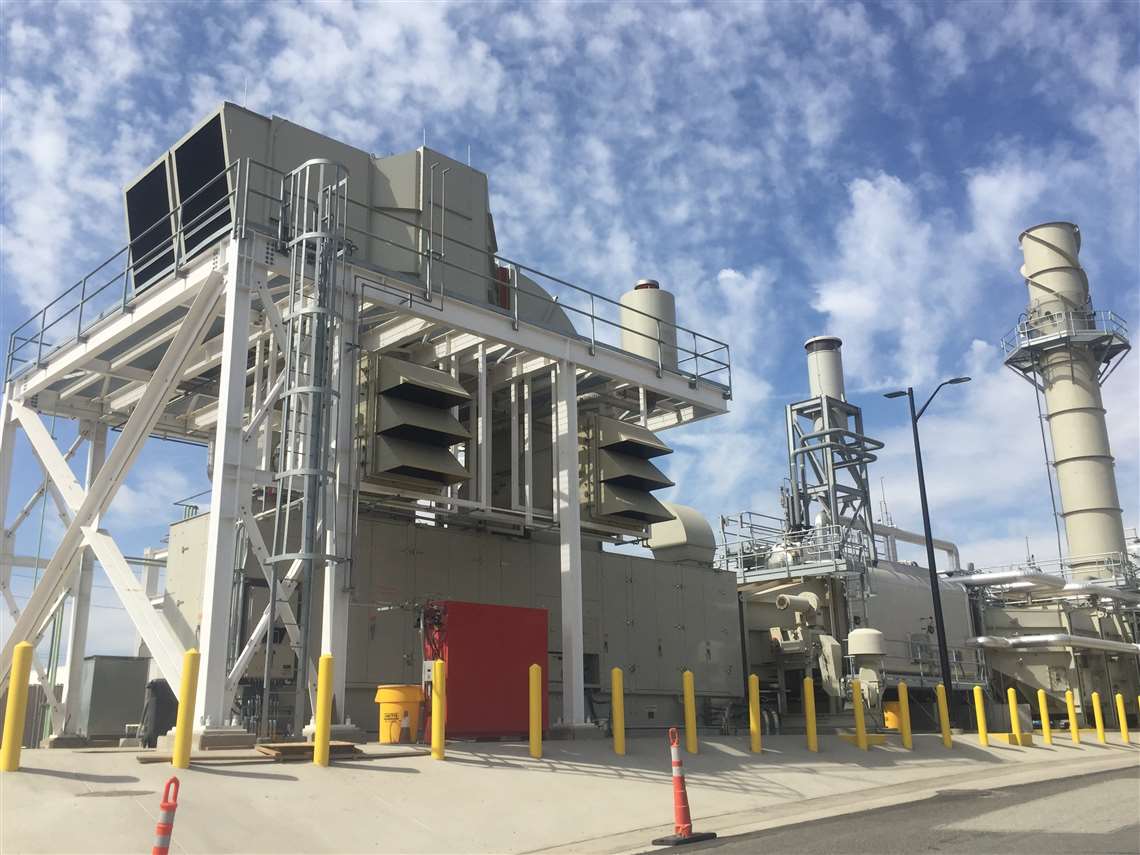 Two Titan 130 generator sets provide the Ontario, California, USA, facility with 100% of its electrical requirements as well as steam for drying the paper during production.
Two Titan 130 generator sets provide the Ontario, California, USA, facility with 100% of its electrical requirements as well as steam for drying the paper during production.
New-Indy previously owned and operated a CHP plant that provided steam and power to the existing paper mill facility and to the new box plant adjacent to the main plant. The existing CHP plant was at the end of its service life. Due to the increased maintenance cost, environmental fees and changes in environmental regulations, New-Indy decided to upgrade their existing CHP plant with a new, efficient and environmentally friendly system. The new upgraded CHP plant uses natural gas for all operations to produce power and steam. The two new Titan 130 gas turbines from Solar are fitted with SoLONOx emissions systems and will be much cleaner and more efficient that the replaced unit, the company said.
These two Titan 130 generator sets provide the Ontario manufacturing facility with 100% of its electrical requirements, steam for drying the paper during production and power to the grid. New-Indy said it prides itself on its environmentally conscious manufacturing processes that enable it to maintain a strong business presence in the market it services.
Additionally, New-Indy purchased a full-service agreement with Solar Turbines for the two Titan 130 generator sets. This provides a long-term service solution that is designed to help extend the life of their equipment by providing a fixed service cost over the long term and significantly reducing financial risk of equipment reqpirs. This comprehensive service offering includes several service capabilities that, when combined, will successfully maintain the operational health of the machinery and mitigate unplanned machinery downtime while extending its lifecycle.
Flexible power, rain or shine
22.7 MW plant in Mississippi relies on Wärtsilä gas engines
Its efficiency and reliability make the Wärtsilä 31SG the engine of choice for utilities that are transitioning to renewables. The case of Cooperative Energy in Mississippi is one such example, allowing for flexible generation to support solar power, as well as resiliency in case of hurricanes.
A 22.7 MW flexible gas power plant with two highly efficient Wärtsilä 20V31SG gas engines as prime movers started commercial operations in Benndale, Mississippi, USA in April 2020. The plant is owned by Cooperative Energy, a member-owned not-for-profit electric cooperative, covering 432 000 homes and businesses in Mississippi. Wärtsilä supplied the plant on a full Engineering, Procurement & Construction (EPC) contract, mitigating thus financial and timing risks in construction.
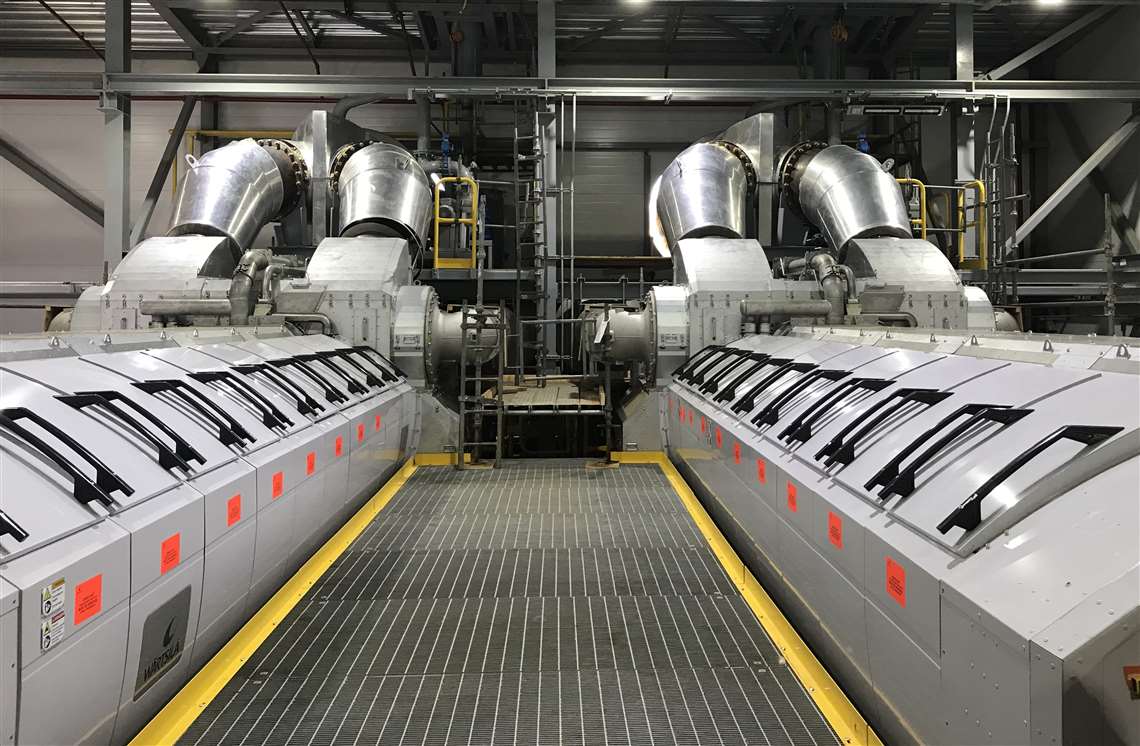
Cooperative Energy’s mission is to provide its members with electricity that is both reliable and economical. According to Cooperative Energy, the Wärtsilä engines provide efficiency that is far greater than any of the company’s simple cycle units, while also adding flexibility to the company’s generation fleet. In 2005 coal produced more than half of their energy, but today cleaner natural gas makes up about two-thirds of the mix. Cooperative Energy also has ten solar sites, showing the increasing importance of Mississippi’s sunshine in providing power.
Power plant with a critical role
The plant provides valuable grid support for renewable integration for the Cooperative Energy system today and in the future, as well as reliability during potential transmission outages caused by hurricanes or other severe weather conditions. Summer in Mississippi is defined by hot sunshine, and hurricane season provides its well-known challenges. Weather plays a vital role in Mississippi’s energy system and was on top of the agenda when Cooperative Energy began to talk to Wärtsilä about upgrading their Benndale plant. The plant is located in the southern part of the power system and has an important role in restoring critical loads in the area.
Cooperative Energy was not only looking for reliability, quick start, efficiency and good operational flexibility, but they also needed black start capability. The Benndale plant can carry out initial energisation of sections of the network so it can provide power to critical local infrastructure like hospitals, communications and other larger units in the system to facilitate full restoration of the grid. The Wärtsilä solution meets all the customer needs which is important for both Cooperative Energy and the community.
Record-setting technology
The diesel version of the Wärtsilä 31 engine has been recognized by Guinness World Records as being the world’s most efficient 4-stroke diesel engine. The generating set can provide up to 49% open-cycle electrical efficiency. It has a very wide load range from 10% to 100%. While the plant is not running it has very small stand-by power consumption. Importantly also, the plant efficiency is not significantly changed in more hot, cold or humid conditions and it is very resilient against output derating against different gas qualities or ambient conditions.
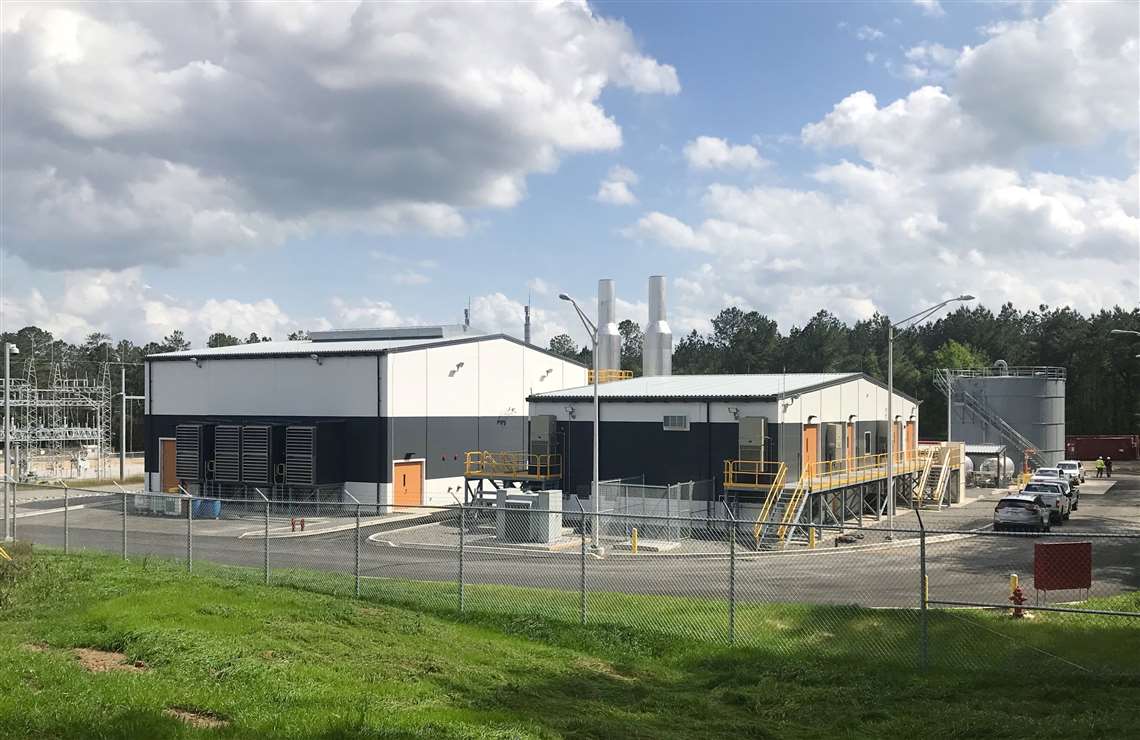 A 22.7 MW flexible gas power plant with two highly efficient Wärtsilä 20V31SG gas engines as prime movers started commercial operations in Benndale, Mississippi, USA in April 2020.
A 22.7 MW flexible gas power plant with two highly efficient Wärtsilä 20V31SG gas engines as prime movers started commercial operations in Benndale, Mississippi, USA in April 2020.
Flexibility is perhaps the most important value required from dispatchable power generation equipment. Wärtsilä 20V31SG provides full power in just 2 minutes from start command and it gets synchronized with the grid in less than 30 seconds. The engine has continuous minimum load limit at 10%. When running hot it can be loaded at 2% per second. It has no minimum uptime or downtime. The genset has very high partial load efficiency making it a very feasible choice to handle continuously changing load patterns. Whenever there is a saturation of renewable power in the system, generating sets can be stopped individually or all at the same time. There are no limits for start or stops and those do not have impact on overhaul schedule of the engines.
The first year of operation of the Benndale plant has demonstrated the flexibility and efficiency of Wärtsilä 20V31SG engine technology. Recent operating results show the full load LHV heat rate of the plant achieving 6989 Btu/kWh.
Harnessing the power of green hydrogen
Germany utility works with INNIO on going green
According to the International Energy Agency (IEA), the power sector produces 40% of the world’s CO2 emissions. This intense production of greenhouse gases is driving the power industry to an intense competition to present economical, safe, clean alternative energies as the world transitions from fossil fuels to cleaner technologies that will reduce its carbon footprint. Hydrogen has re-emerged as a viable technology for large scale industrial electrification. INNIO is disrupting the electricity industry by proving that green hydrogen-run power plants are not only a theoretical solution to large-scale, industrial electrification, but are a real, workable solution. In 2020, INNIO worked closely with German utility HanseWerk Natur to build a pilot “Green Utility” that can generate power and heat with an INNIO gas engine fueled with 100 percent hydrogen, a mixture of hydrogen and natural gas or natural gas in Hamburg, Germany.
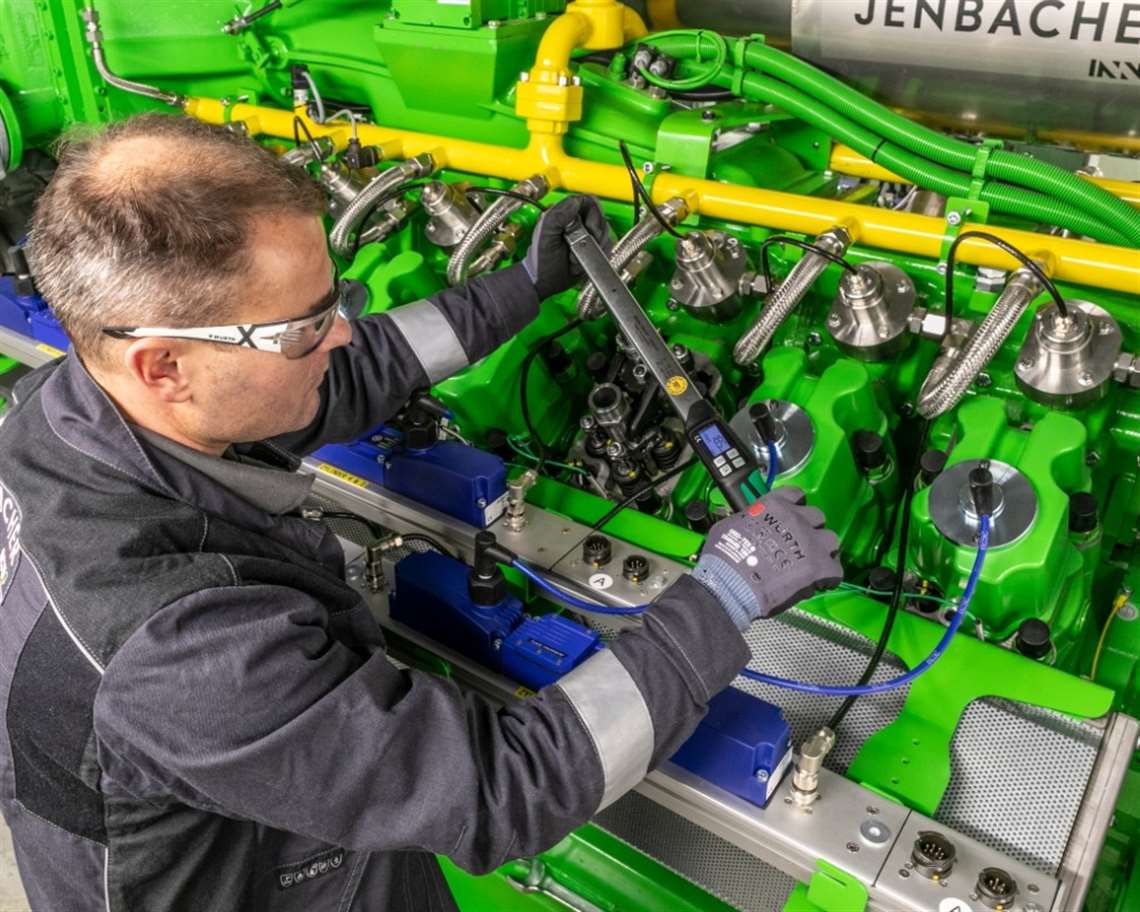 INNIO worked with German utility HanseWerk Natur to develop a hydrogen-fueled combined heat and power (CHP) plant in the 1 MW range in the center of Hamburg. The plant started field testing in November 2020.
INNIO worked with German utility HanseWerk Natur to develop a hydrogen-fueled combined heat and power (CHP) plant in the 1 MW range in the center of Hamburg. The plant started field testing in November 2020.
Hydrogen-fueled CHP plant
INNIO worked with German utility HanseWerk Natur to develop a hydrogen-fueled combined heat and power (CHP) plant in the 1 MW range in the center of Hamburg. The plant started field testing in November 2020. This flagship pilot project led to the large-scale execution of hydrogen technology in CHP plants. “By field testing this INNIO CHP plant with up to 100% hydrogen, we are demonstrating that a greener, more reliable, more flexible, and future-orientated energy supply for Hamburg is technically feasible,” explained Thomas Baade, Technical Director of HanseWerk Natur GmbH. The converted CHP plant is part of the heating network in Bahrenfeld, in which HanseWerk Natur provides 30 residential buildings, a sports center, a daycare center, and the Othmarschen Park leisure complex with a reliable supply of local heating that equates to 13 000 MW/h every year. The electricity generated is fed to electric vehicle charging points in Othmarschen’s multi-level parking garage as well as to the local power grid.
“Together with HanseWerk Natur, we are paving the way for a future energy supply in Hamburg that is greener, more secure, more flexible and more decentralized,” said Carlos Lange, president and CEO of INNIO. The output will be fed into HanseWerk Natur’s local heating network, serving approximately 1.3 million customers. The use of hydrogen-fueled engines as a source of safer, cleaner energy is paving the way forward for decentralized applications for communities around the world. A 16-cylinder gas engine from INNIO Jenbacher, for example, that once ran on natural gas can now run on 100 percent hydrogen or any mixture of hydrogen and natural gas or natural gas. With hydrogen as a fuel source, there are no CO2 emissions because hydrogen is combusted CO2 free.
The Green Utility facility, located in Jürgen-Töpfer-Strasse in central Hamburg, has an electrical output of 999 kW in natural gas mode and runs on variable hydrogen/natural gas mixes, as well as 100% green hydrogen. The facility, which has been optimized for use with natural gas, is remarkable for its excellent overall efficiency of 93%. When operating with pure hydrogen or hydrogen blends, the output will be adjusted accordingly. The heat generated is fed into HanseWerk Natur’s local heating network, while electrical energy is fed into the grid and made available for recharging electric vehicles at the site when required. The integrated energy system combining the electricity, heating and gas networks is the key to a greener energy future. By using power-to-gas (P2G) technology, Green Hydrogen is converted from surplus renewable energy produced mainly from the sun and wind. Unlike electricity, it can be stored long term in tanks or in large quantities in underground caverns—like natural gas—over months or seasons.
Green hydrogen opportunities
Initially, green hydrogen produced with P2G technology will be expensive, and the volume produced will be limited. During this transitional stage—as research continues green hydrogen technologies—blue hydrogen produced from natural gas with Carbon Capture Utilization and Storage (CCUS) can play a role and enable the transition. A small amount of hydrogen can be fed into the existing natural gas network, with larger amounts of hydrogen transported in a separate infrastructure. Hydrogen as a fuel could be used locally across all sectors including industry, transportation, and CHP generation. Columbia University’s Earth Institute reports that many experts view Green Hydrogen as essential to meeting the goals of the Paris Agreement when considering that certain portions of the economy produce emissions that are difficult to eliminate. In the U.S., the top three sources of climate-warming emissions come from transportation, electricity generation and industry.
Green hydrogen offers Northern Germany significant opportunities given its vast wind resources and increasing importance as an energy storage medium. As the energy industry continues to look toward wind-generated electricity conversion into green hydrogen, it is also seeing how it can be deployed across the power, heat, transportation and industrial sectors. In January 2020, the German government responded to the efforts of energy companies like INNIO by approving Germany’s nationwide phaseout of coal generation by 2038.
By definition, green power sources, such as INNIO’s and HanseWerk Natur’s 100 percent hydrogen fueled power plant, operate as zero-emission energy sources. Essentially, green energy sources produce no additional carbon dioxide nor other greenhouse gases across the power generation process. This flagship pilot project will not only drive forward the large-scale use of hydrogen technology in CHP plants, but the city of Hamburg has also set itself the goal of ensuring that all interested customers in the power, heat and transportation sectors can be supplied almost entirely with Green Hydrogen by 2035.
Green hydrogen can be reconverted by flexible gas engine power plants into dispatchable renewable power. Like natural gas, it is ideally suited for CHP applications and can provide heating and cooling while achieving a fuel utilization rate of 90% and more. Gas engines running on hydrogen are a mature technology, do not require high hydrogen purity, are available at very competitive CAPEX and OPEX, and provide necessary operating flexibility while achieving very low emissions. Further, hydrogen gas engine power plants are CO2 neutral and can achieve more than 80% lower NOx emissions compared to natural gas. This solution will put the world on the path to a greener future.
STAY CONNECTED




Receive the information you need when you need it through our world-leading magazines, newsletters and daily briefings.
POWER SOURCING GUIDE
The trusted reference and buyer’s guide for 83 years
The original “desktop search engine,” guiding nearly 10,000 users in more than 90 countries it is the primary reference for specifications and details on all the components that go into engine systems.
Visit Now
CONNECT WITH THE TEAM










